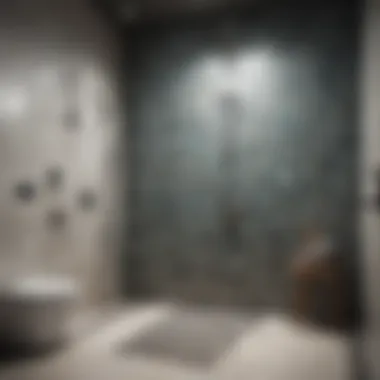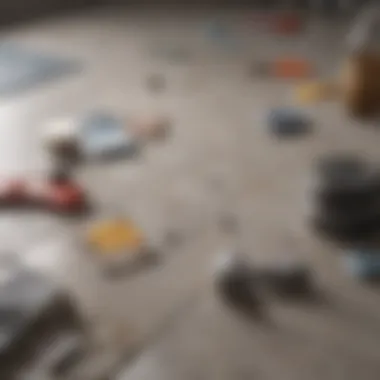Cost Analysis of Tiling a Shower: A Comprehensive Guide


Intro
Tiling a shower is more than a mere aesthetic choice; it is a crucial investment for homeowners who wish to enhance the functionality and appeal of their bathroom space. As with any home improvement project, understanding the financial implications is key. Not only do the costs vary widely based on materials used and installation methods, but they can also be influenced by regional labor rates and the complexity of the design.
In this guide, we will explore the intricate details of what contributes to the overall cost of tiling a shower. This includes material costs, labor expenses, and preparatory requirements that should not be overlooked. The aim is to arm homeowners with the knowledge necessary for making informed decisions, clearly identifying what to budget for each stage of the tiling project.
Understanding the Basics of Shower Tiling Costs
Tiling a shower is a significant home improvement project that carries financial implications. Understand the basics of shower tiling costs helps homeowners in planning their budgets effectively. Knowing what to expect in terms of tile types, labor costs, and additional materials can save money in the long run. The decision-making process can be quite intricate, as both aesthetic outcomes and practicality must be weighed against costs.
Overview of Tile Types and Pricing
Tile selection is one of the most crucial steps in the tiling process. Various types of tiles offer different prices, qualities, and aesthetic appeal. Common types of tiles include:
- Porcelain: Known for durability and water resistance, porcelain tiles generally range from $3 to $10 per square foot.
- Ceramic: A more economical option, ceramic tiles can cost as low as $1 to $5 per square foot.
- Natural Stone: This category includes materials like granite and marble. Their price can range widely from $5 to over $20 per square foot, depending on the rarity and finish.
- Glass Tiles: These tiles are often used for accents or borders and typically cost between $7 and $30 per square foot.
Understanding these price ranges can help in selecting tiles that fit both the budget and aesthetic desires.
Labor Costs: What to Expect
Labor costs vary widely based on the experience of the installer and the complexity of the project. On average, homeowners can expect to pay between $4 and $10 per square foot for labor.
- Experienced Contractors: Hiring professionals with a solid reputation often means paying a premium. However, this investment can lead to higher-quality work.
- Inexperienced Installers: Some may choose to go with less experienced workers to cut costs. This approach can backfire if the installation is subpar, leading to future repairs.
When calculating the total cost, it is important to factor in both tile and labor expenses to get a realistic picture of the project costs.
Additional Materials and Supplies
Beyond tiles and labor, other materials can significantly impact overall costs. Essential supplies like:
- Adhesives: Thin-set mortar or mastic to attach tiles costs around $10 to $20 per bag.
- Grout: Typically costs between $5 and $15 per bag, depending on the type and color.
- Backer Board: A waterproof substrate to support tiles and costs about $10 to $15 per sheet.
- Trim and Edging Materials: These finishing touches can also add to the overall budget.
In summary, a thorough understanding of various tiling costs establishes a foundation for effective budgeting. Being informed ensures that every dollar spent is strategic and aligns with desired outcomes.
Factors Influencing Overall Costs
Understanding the factors that influence the overall costs of shower tiling is essential for homeowners. This insight helps in making informed decisions that can prevent overspending while ensuring the desired aesthetic outcome. Several elements come into play when determining the total price of a tiling project, and being aware of these can aid in more effective budgeting and planning.
Size of the Shower Area
The size of the shower area is a primary factor affecting tiling costs. Larger shower spaces require more tiles, which directly increases material costs. Additionally, more significant areas often lead to increased labor time. For example, a standard shower generally covers around 30 square feet, while larger ones or luxurious walk-in showers can exceed 50 square feet.
When measuring for tiles, be precise. Take into account the height and width of walls and the base. If you are considering adding accents or decorative patterns, the design complexity will further increase the total square footage and cost.
Complexity of the Design
Design complexity plays a vital role in estimating costs. Intricate layouts require more precise cutting and fitting of tiles, which consumes more time and effort. Patterns such as herringbone or chevron not only require additional tiles due to wastage from cutting but also demand a skilled installer who can maintain uniformity throughout the design.
More straightforward designs, like standard grid patterns, dramatically reduce labor time and, consequently, the associated costs. Familiarizing oneself with various tile layouts and their required intricacies can guide homeowners in choosing designs that align with their budget constraints.
Condition of Existing Surface
The existing surface's condition can significantly impact tiling costs. If the surface is unstable or damaged, it may need repairs before tile installation begins. This preparation ensures a level, durable foundation for the new tiles. Common issues include cracks, mold, or water damage, which may require extensive work to rectify.


Neglecting to address underlying surface conditions may lead to poor tile adhesion, potential failures, or costly repairs down the line. Addressing these issues beforehand might seem like an additional expense but can save a homeowner significant costs and headaches later.
"Investing time and resources upfront in preparing the surface can prevent future problems and increase the longevity of the tile installation."
In summary, the total costs involved in shower tiling hinge substantially on the size of the area, design complexity, and the existing surface condition. A thorough evaluation of these factors enables homeowners to create accurate budgets and makes informed choices throughout the tiling process.
Breaking Down Tile Cost Estimates
Understanding the costs associated with shower tiling involves breaking down various estimates. This section is crucial as it offers clarity, allowing homeowners to anticipate expenses accurately. By dissecting the cost components, one can make better decisions regarding materials and labor. It further aids in understanding how different elements contribute to overall pricing. This analysis helps in managing budgets effectively.
Calculating Square Footage
Calculating the square footage of your shower area is a foundational step in estimating costs. To do this, you need to measure the width and height of the shower walls and the floor. Multiply these dimensions together to get square footage. Account for any fixtures or areas where tile will not be installed. Knowing the total area allows for precise calculation of both tile and labor costs.
Price Range of Various Tile Materials
When it comes to tile materials, various options present different price ranges and characteristics. Choosing the right material is essential not only for aesthetics but also for the budget. Here is an overview of the different types of tiles:
Porcelain
Porcelain tiles are known for their durability and resistance to moisture. They typically cost between $3 to $10 per square foot. A key characteristic of porcelain is its density, making it less prone to cracking. This feature makes it popular for shower installations. The primary disadvantage, however, is its weight, which may require additional support during installation.
Ceramic
Ceramic tiles are more affordable, ranging from $1 to $8 per square foot. They are versatile and come in various colors and designs. A significant characteristic is their ease of maintenance. While durable, ceramic may not offer the same level of moisture resistance as porcelain. This can be a concern in wet environments, which shower areas are.
Natural Stone
Natural stone tiles, such as marble or granite, can vary widely in price, starting around $5 and reaching up to $15 or more per square foot. The distinct patterns and finishes of natural stone make it an appealing choice for many homeowners. However, care must be taken, as natural stone often requires sealing to prevent water absorption and staining.
Glass Tiles
Glass tiles provide a unique aesthetic and typically range from $7 to $30 per square foot. Their reflective qualities enhance lighting in a shower space. One advantage is that they are highly resistant to moisture. On the downside, glass tiles can be more fragile and may require careful handling during installation.
Understanding these materials helps in planning and budgeting for a shower tiling project. Each option comes with its unique features, costs, and trade-offs that can impact your overall investment.
"Each tile material presents distinct benefits and challenges, shaping the design and functionality of your shower."
Labor Costs: Professional vs. DIY
When planning a shower tiling project, one of the most significant factors to consider is the cost associated with labor. This decision can influence the overall budget greatly. Homeowners often face the choice of hiring a professional tiler or taking on the task themselves. Each option has its own advantages and disadvantages, which must be carefully weighed.
Pros and Cons of Hiring Professionals
Engaging a professional tiler has specific benefits. Firstly, expertise plays a vital role. Professionals bring experience and know-how to the table, ensuring that both aesthetics and functionality are prioritized. Their familiarity with industry standards means proper installation, which is essential for longevity and minimizing future repairs. Additionally, professionals often come with access to specialized tools and materials, which might not be available to a DIY novice.
However, there are downsides to hiring someone. Cost is the most apparent drawback. Professional services can escalate total expenses, which may strain tight budgets. In some cases, if unexpected changes arise, professionals may charge additional fees that could push costs even higher. Also, scheduling can present challenges, as timing may not always align with the homeowner's preferences.
Assessing Your DIY Skills
Understanding your own capability is crucial when considering a DIY project. Skill level plays a significant role in whether this option is feasible. For instance, if you have experience in home renovations, tiling might be manageable. Conversely, if you lack any experience with tile installation, the project can quickly become overwhelming.
It may be helpful to evaluate past projects or seek advice from trusted friends or family who have tackled similar tasks. Resources like instructional videos or online forums might provide additional insight. If you feel confident in measuring, cutting tiles, and applying adhesives accurately, DIY could prove rewarding. However, if uncertainties persist, it may be wise to reconsider your approach.
Time Investment in DIY Projects


Time is another critical element in deciding between hiring professionals or doing it yourself. An experienced tiler can often complete a shower in a few days. For a DIY project, this timeline can extend significantly. Homeowners may not realize the commitment involved until they begin the work. Tasks such as planning, measuring, and setting tiles can take longer than anticipated, especially for those less experienced in home improvement.
Consider potential interruptions in your schedule. If you have time constraints due to work or other commitments, a professional may help ensure timely completion. Conversely, if you have flexibility and can carve out blocks of time, a DIY approach may be a fulfilling challenge.
The decision between hiring professionals and taking the DIY route hinges on a careful assessment of skills, time, and budget.
Ultimately, whether hiring skilled labor or utilizing your abilities, each option carries unique financial implications. Recognizing these factors can help clarify which path is best suited for your shower tiling project.
Common Mistakes to Avoid in Shower Tiling
Tiling a shower can transform its look and feel dramatically. However, the process is prone to mistakes that can lead to significant cost overruns and unsatisfactory results. This section outlines common errors that homeowners and DIY enthusiasts should be wary of. By understanding these pitfalls, one can approach the project with greater knowledge and confidence, ensuring a smoother tiling experience and an end result that meets expectations.
Choosing the Wrong Materials
Selecting the appropriate materials is a critical element in any tiling project. Investing in the wrong tile can lead to aesthetic and functional issues. For instance, opting for a low-quality ceramic tile may save money upfront but could lead to premature wear, staining, or water damage over time. Conversely, premium materials like natural stone or porcelain offer durability but at a higher cost.
The mistake often lies in the lack of understanding of each material's properties. Here are a few factors to consider:
- Suitability for wet areas: Ensure tiles can withstand humidity and water exposure to avoid mold growth.
- Slip resistance: It is crucial for safety, especially in a shower setting.
- Maintenance requirements: Some materials require more upkeep than others, impacting long-term costs.
Neglecting Waterproofing Needs
Waterproofing is a foundational step that should never be overlooked. Ignoring this aspect can lead to severe problems, such as structural damage or mold growth. A proper waterproofing layer is essential before laying tiles.
Common mistakes include:
- Using inadequate waterproofing products: Some homeowners may opt for cheaper solutions that do not meet industry standards.
- Overlooking areas like corners and joints: These spots are particularly vulnerable and require special attention.
- Failing to test the waterproofing system: Testing should be done before tiling to confirm that no leaks exist.
Taking these waterproofing measures seriously can save substantial costs in repairs down the line, ensuring the longevity of the installation.
Underestimating the Project Timeline
Every tiling project has its timelines, and underestimating these can lead to frustration and increased expenses. Rushing through can result in careless mistakes, leading to rework that consumes additional time and resources.
Key considerations include:
- Preparation time: Remove old fixtures, assess the underlying surface, and ensure it is ready for tiling.
- Tile drying time: Mosaics and grouts generally require specific drying times for optimal adherence and finish.
- Curing time before use: After tiling, there is a curing period before the shower can be used comfortably.
Establishing a realistic timeline with contingency for unexpected delays can improve the overall project experience and satisfaction with the end product.
"Avoiding common mistakes in shower tiling not only enhances the final appearance but also ensures sustainability and financial prudence."
With this understanding, homeowners can approach their shower tiling projects with the foresight necessary to make informed decisions and avoid costly errors.
Budgeting for Your Shower Tiling Project
Budgeting plays a crucial role in any home improvement project. When it comes to tiling a shower, an effective budget not only dictates what materials and labor you can afford, but it also helps foresee potential financial hurdles. It allows homeowners to make informed decisions that align with their aesthetic preferences and functional needs. A well-planned budget can make the difference between a successful project and a frustrating experience where costs spiral out of control.
Creating a budget involves multiple elements. Homeowners should take into account the specific materials they desire, the labor costs they must cover, and any unforeseen expenses that may arise during the process. This assists in maintaining focus and ensuring that extravagant spending does not undermine the overall goal. Careful budgeting can also ease the stress often associated with home renovations, knowing the project stays within financial limits without sacrificing quality.
Creating a Comprehensive Budget
To form a solid budget for shower tiling, begin with listing all necessary materials. This includes the tiles themselves, adhesive, grout, and any tools you might need if undertaking the project as a DIY. Each component contributes noticeable costs:
- Tiles: Select a type that aligns with both your style and budget limits.
- Adhesive and Grout: Choices vary, affecting not just price but lifespan and maintenance needs.
- Tools: If lacking tools, consider rental options to minimize expenses.


Next, estimate labor costs. A typical professional installation may take significant time and requires expertise. Incorporate the hourly rate or total cost of hiring a professional tiler.
When evaluating all these aspects, aim to receive multiple quotes from different suppliers and installers. Consider the overall project scope and dedicate time to adjustments to your budget as you move along. The objective is to create a budget that is detailed yet flexible, accommodating changes that might arise during the process.
Incorporating Contingency Funds
Unexpected issues can easily derail even the best-planned tiling projects. This is why incorporating contingency funds into your budget is essential. A common recommendation is to set aside 10% to 20% of your overall budget to cover unforeseen costs. These could stem from:
- Damage to the existing wall requiring repairs.
- The necessity of additional materials if initial estimates were incorrect.
- Labor adjustments due to project complications, such as intricate design choices.
Setting aside a contingency budget offers a safety net, alleviating the financial burden experienced through sudden expenses. This allows the project to progress smoothly without the risk of stopping halfway through due to lack of funds.
Financing Options Available
For those who find the upfront costs of tiling a shower overwhelming, financing options are available. Understanding these options can provide flexibility in managing expenses:
- Home Improvement Loans: A personal loan aimed specifically at home renovations can often cover larger sums needed for the project.
- Credit Cards: Utilizing credit could offer short-term solutions, especially for purchasing materials. However, be cautious of interest rates.
- Store Financing Plans: Some retailers provide financing plans with deferred payment options or low-interest rates. This can be a strategic way to manage expenses.
Evaluate the implications of each financing method. Compare interest rates, repayment terms, and overall impact on your financial situation. Prioritize long-term viability over short-term gain.
Proper planning and a clear understanding of budgeting can transform your shower tiling project from a daunting task into a manageable and rewarding endeavor.
Common Trends in Shower Tiling
Understanding common trends in shower tiling is essential for homeowners and design enthusiasts alike. Keeping up with these trends not only ensures that your shower looks contemporary but also helps to enhance the overall value of your home. Moreover, trends often reflect innovations in materials, design philosophies, and sustainability practices that can result in a more efficient and visually appealing space.
Current Design Trends
Recent years have seen a shift towards bolder design choices in shower tiling. Homeowners are increasingly opting for large-format tiles, which can create a more seamless and spacious appearance. This choice reduces grout lines, making cleaning easier and providing a sleek look. Additionally, geometric patterns are gaining popularity. These designs can serve as a focal point within shower spaces, allowing for customization and personal expression in otherwise utilitarian environments.
Colors are also evolving. Neutral tones like grays and whites dominate, but there is a growing appetite for earth tones and vibrant accents. This variety enables homeowners to create a tailored aesthetic that matches their personal style while still being appealing to potential buyers.
Eco-Friendly Material Choices
Sustainability in home design is more than a trend; it reflects a significant shift in consumer preferences. Eco-friendly materials are becoming the go-to choice for many homeowners. For example, recycled glass tiles are popular due to their unique appearance and lower environmental impact. Bamboo is also making its mark as a sustainable alternative for wall coverings, offering a unique texture that adds warmth to any shower space.
Moreover, consider the longevity of these materials. Many eco-friendly tiles, such as porcelain and natural stone, not only reduce the carbon footprint but also stand the test of time. This durability can translate to lower long-term costs, as less frequent replacements are required.
In summary, being aware of common trends in shower tiling can greatly assist in making informed choices that reflect both current design aesthetics and environmental considerations. This knowledge can enhance the overall experience and satisfaction with the finished project.
Final Considerations When Tiling a Shower
Tiling a shower is often seen as a project full of aesthetic potential, but it also comes with a number of financial implications that shouldn’t be overlooked. When planning a shower tiling project, it is essential to consider both short-term and long-term factors that affect overall cost and utility. This section discusses long-term maintenance costs and resale value implications, providing a deeper insight into the investment involved in shower tiling.
Long-Term Maintenance Costs
After the excitement of installing new tiles, many homeowners fail to account for the ongoing maintenance costs that accompany their choice. Cleaning and upkeep are crucial in preserving the look and functionality of tiled surfaces. Various tile materials have different maintenance requirements.
- Ceramic and Porcelain: These materials are often resistant to mold and mildew, making cleaning a simpler task. However, they still require periodic sealing, particularly the grout lines, to prevent staining and moisture infiltration.
- Natural Stone: While beautiful, natural stone tiles such as marble or travertine require more extensive care. They are often more porous, necessitating regular sealing and special cleaning solutions to maintain their appearance.
- Glass Tiles: These tiles can be easier to clean but might show water spots and soap scum, which need extra attention.
Ignoring maintenance can lead to costly repairs down the line. For example, dilapidated grout can allow water to seep behind tiles, resulting in mold growth or wall damage. Homeowners should weigh these long-term costs against their initial budget to avoid unforeseen expenses.
Resale Value Implications
Another important aspect to consider is how the choice of tiles and the quality of installation impact the resale value of the home. A well-tiled shower not only enhances the bathroom's aesthetic appeal but also serves as a selling point for potential buyers.
- High-Quality Materials: Investing in tiles that are durable and stylish can significantly increase resale value. Buyers are often willing to pay a premium for homes featuring beautiful, well-maintained bathrooms.
- Trendy Designs: Keeping up with current design trends can also help attract buyers. For instance, large-format tiles and minimalistic designs have gained popularity in recent years.
- Functionality: Features like a curbless shower entrance or built-in storage solutions can enhance usability, ultimately making the space more desirable.
However, if the installation is botched or if low-quality materials are used, it can have the opposite effect, decreasing property value. Therefore, ensuring professional quality workmanship and meticulous planning is essential.
"Investing in tile quality and professional installation can pay off, not only in daily enjoyment but also when it comes time to sell your home."



